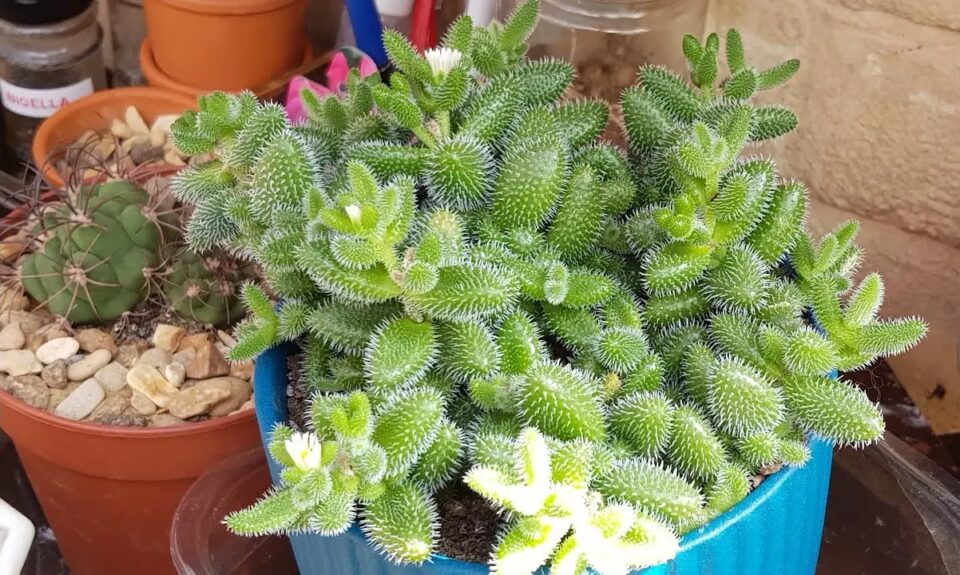Succulents have been growing in popularity in recent years, with their unique shapes and easy-to-care-for nature. One succulent that stands out from the rest is the pickle plant (Delosperma echinatum).

With its green cylindrical leaves and bright yellow flowers, the pickle plant is an eye-catching addition to any succulent collection. In this article, we’ll explore everything you need to know about growing and caring for pickle plants.
The pickle plant is a small, low-growing succulent native to South Africa. Its leaves grow in cylindrical shapes, resembling tiny pickles, and can reach up to 2 inches in length. The plant blooms in the summer, producing bright yellow flowers that last for several weeks.
| Plant Profile | |
|---|---|
| Common Name | Pickle plant, Ice plant |
| Scientific Name | Delosperma echinatum |
| Type | Succulent |
| Origin | South Africa (Eastern cape) |
| Habitat | Rocky habitats |
| Size | 45 cm (18″) tall |
| Toxicity | Non-toxic to pets and humans |
| Colors | Green/Lime |
| Blooms | White to yellow flowers from spring |
How to Care Pickle Plant?
Pickle plants are relatively low-maintenance and can thrive in a variety of conditions. Here are some key care tips to keep in mind:
- Light: Pickle plants prefer bright, indirect sunlight. The plant should be placed close to a window that gets a lot of natural light, but direct sunlight should be avoided since it might burn the leaves.
- Watering: Pickle plants are drought-tolerant and do not require frequent watering. Water the plant thoroughly, then allow the soil to dry out completely before watering again. Overwatering can lead to root rot and other issues, so be careful not to let the soil become waterlogged.
- Temperature: Pickle plants prefer warm temperatures between 65-80°F (18-27°C). They can tolerate cooler temperatures, but it’s best to avoid exposing them to temperatures below 50°F (10°C).
- Humidity: Pickle plants can tolerate low humidity, making them a good choice for indoor environments. However, they may benefit from occasional misting or a humidifier during periods of dry weather.
By following these care tips, you can help your pickle plant thrive and grow.
How to Propagate Pickle Plant?
Pickle plants can be propagated easily through stem cuttings. Simply cut off a healthy stem, let it dry out for a few days, and then plant it in well-draining soil. The cutting should take root within a few weeks and begin to grow new leaves.
Repotting
Pickle plants do not require frequent repotting since they prefer to grow in well-draining soil and can tolerate being root-bound. However, if the plant has outgrown its current container or the soil has become compacted, it may be time to repot.
When repotting, it’s important to use a well-draining soil mix and choose a pot with drainage holes to prevent overwatering. Repotting is best done in the spring or early summer, as this is when the plant is actively growing.
Pruning
Pickle plants generally do not require pruning, as they have a naturally compact and low-growing form. However, if the plant becomes leggy or overgrown, it can be pruned back by cutting off the stem tips with sharp, clean scissors or pruning shears.
Pruning can be done at any time of the year, but it’s best to avoid cutting back too much at once to prevent shock to the plant.
Pests and Diseases
Like all succulents, pickle plants are susceptible to mealybugs and spider mites. Regular inspections and treatments with insecticidal soap can help prevent infestations. Being careful with watering practices is vital because excessive watering can also cause root rot.
Common FAQs
Q1: Do pickle plants require a lot of water?
No, pickle plants are drought-tolerant and do not require frequent watering. It’s important to allow the soil to dry out completely between waterings to prevent overwatering, which can lead to root rot and other issues.
Q2: Can pickle plants be grown indoors?
Yes, pickle plants can be grown indoors as long as they are placed in a bright location with plenty of indirect sunlight. They are a great choice for indoor environments because they can tolerate low humidity and do not require frequent watering.
Q3: How often do pickle plants bloom?
Pickle plants typically bloom in the spring and summer months. The white-to-yellow flowers can last for several weeks and add a beautiful pop of color to the plant’s overall appearance. With proper care, pickle plants can bloom annually.
